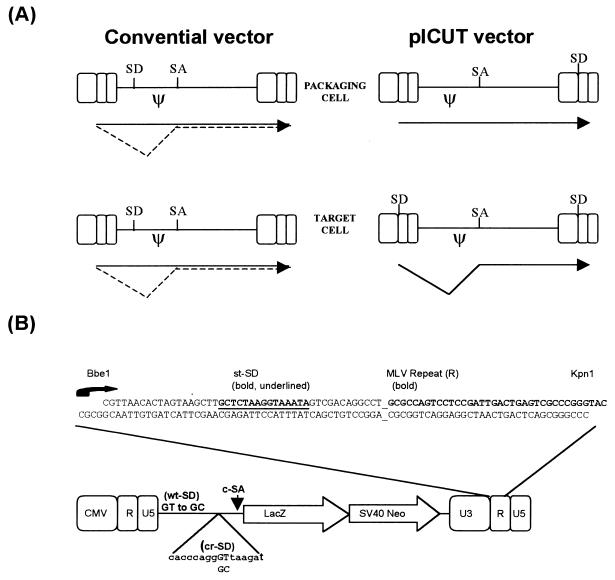FIG. 1.
Design and function of the pICUT vector. (A) Comparison of splicing events in conventional and pICUT vectors. Conventional vectors such as MFG (6, 15, 30) and pLXSN (22) have suboptimal retroviral splice sites such that only a fraction of transcripts are ever spliced in packaging cells and target cells. For the pICUT vectors, efficient splice sites are instead used and positioned such that splicing occurs only after one round of RT. Consequently, for these vectors the splicing is minimal in transfected packaging cells while maximal in transduced target cells. (B) Construction of vector. A synthetic oligonucleotide containing the splice donor sequence from the SV40 st-SD intron was inserted between the naturally occurring BbeI and KpnI sites of the 3′ LTR of the vector. This oligonucleotide is designed to recreate the start of transcription (represented by a curly arrow and starting with GCGCC) which resides over the BbeI site. Contained within the oligonucleotide is the complete R sequence up to the KpnI site. Also shown is the positioning of the c-SA. This is located downstream of the packaging signal. Because of this overall design, upon one round of RT both the 3′ U3 promoter and the st-SD sequence are copied to the 5′ LTR position (with priming beginning at the 5′ terminus of R). Consequently, transcripts synthesized now contain a functional intron with the 5′ and 3′ splice sites located on either side of the packaging signal (ψ). Certain pICUT vectors also contain further modifications of both wild-type and cryptic SD sites located within the packaging signal (see also Fig. 2).

